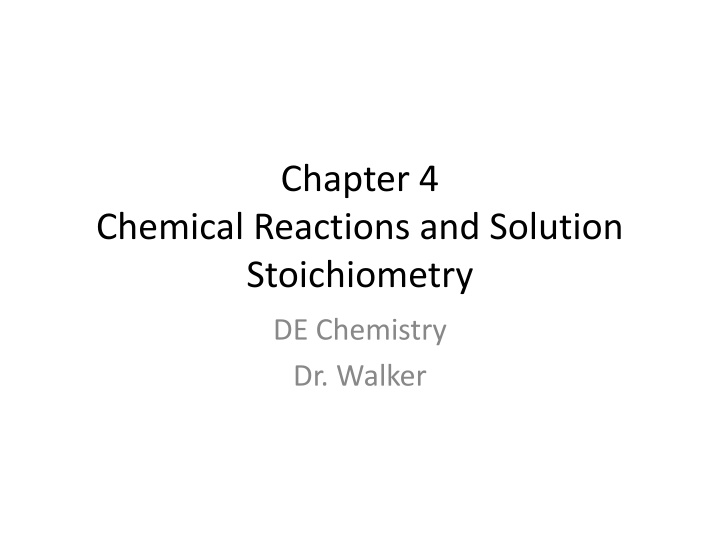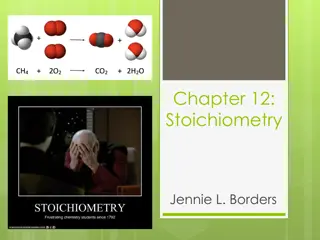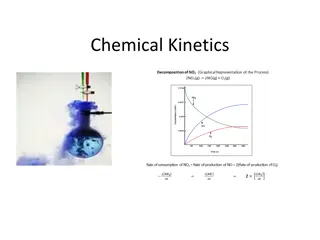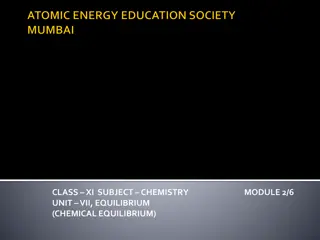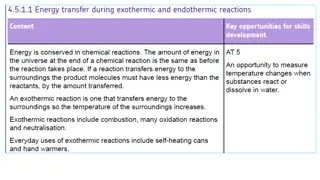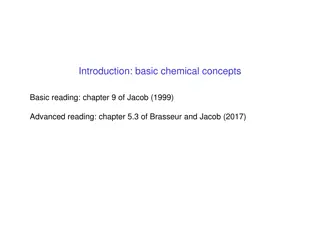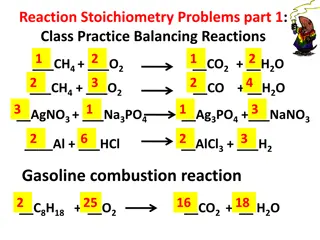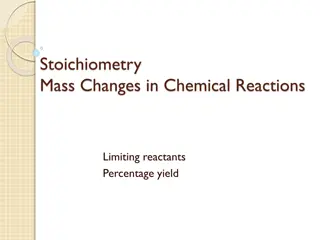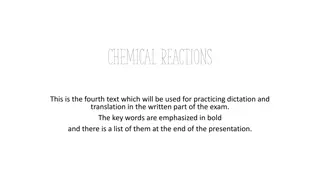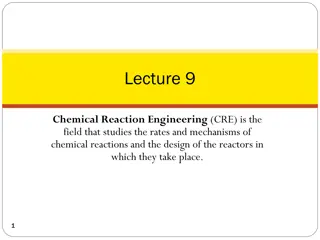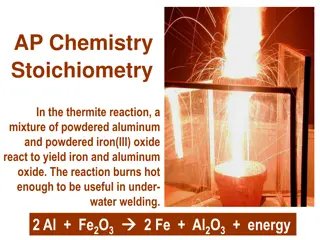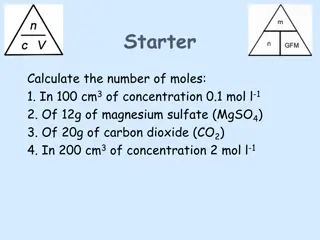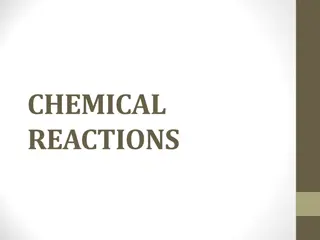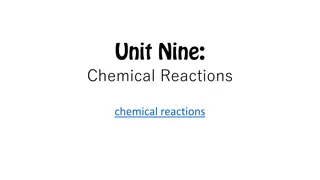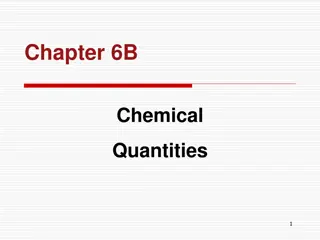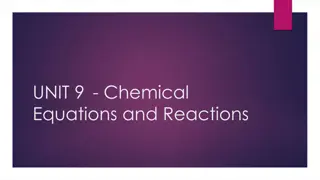Chemical Reactions and Solution Stoichiometry Insights
Dive into the world of chemical reactions, solutions, and stoichiometry in Dr. Walker's chemistry class. Explore concepts like solutes, solvents, electrolytes, molarity, and more in this educational journey through the fascinating realm of chemistry.
Download Presentation

Please find below an Image/Link to download the presentation.
The content on the website is provided AS IS for your information and personal use only. It may not be sold, licensed, or shared on other websites without obtaining consent from the author.If you encounter any issues during the download, it is possible that the publisher has removed the file from their server.
You are allowed to download the files provided on this website for personal or commercial use, subject to the condition that they are used lawfully. All files are the property of their respective owners.
The content on the website is provided AS IS for your information and personal use only. It may not be sold, licensed, or shared on other websites without obtaining consent from the author.
E N D
Presentation Transcript
Chapter 4 Chemical Reactions and Solution Stoichiometry DE Chemistry Dr. Walker
Solutions Homogeneous mixture Solute A solute is the dissolved substance in a solution. Salt in salt water Carbon dioxide in soda drinks Sugar in soda drinks Solvent A solvent is the dissolving medium in a solution. Water in salt water Water in soda
Like Dissolves Like Nonpolar solutes dissolve best in nonpolar solvents Fats Steroids Waxes Benzene Hexane Toluene Polar and ionic solutes dissolve best in polar solvents Inorganic Salts Sugars Water Small alcohols Acetic acid
Water Aqueous Solutions Solutions where a solute is dissolved in water Water is a polar molecule Unequal distribution of electrons in molecule (electronegativity difference) Bent shape due to unpaired electrons on oxygen
The Dissolving Process Hydration Process of dissolving in water Ionic compounds dissociate in water Ions interact with the ends of the water molecule Same process occurs with polar compounds, no dissociation
Electrolytes Conductivity Ability to conduct electric current Requires ions to be present in solution Electrolytes - A substance that when dissolved in water produces a solution that can conduct an electric current Strong electrolytes substances that ionize completely in water Some ionic salts, strong acids/bases Weak electrolytes substances that ionize partially in water Some ionic salts, weak acids/bases Nonelectrolytes substance that DO NOT ionize in water Primarily organic compounds
Electrolytes vs. Nonelectrolytes The ammeter measures the flow of electrons (current) through the circuit. If the ammeter measures a current, and the bulb glows, then the solution conducts. If the ammeter fails to measure a current, and the bulb does not glow, the solution is non-conducting.
Molarity Molarity is the ratio of moles of solute to liters of solution moles of solute = = Molarity M Liter of solution -Remember, you may not always get moles and liters -Grams must be converted to moles (divide by molar mass) -Milliliters must be converted to liters (divide by 1000)
Basic Example Calculate the molarity of a solution prepared by dissolving 1.56 g of gaseous HCl in enough water to make 26.8 mL of solution.
Basic Example Calculate the molarity of a solution prepared by dissolving 1.56 g of gaseous HCl in enough water to make 26.8 mL of solution. 1.56 g HCl 1 mol HCl = 0.00428 mol HCl 36.46 g HCl = 1.60 M HCl 26.8 mL 1 L = 0.0268 L HCl 1000 mL
Concentration of Ions in Solution Same calculations overall One more step multiply the molarity by the number of ions present Give the concentration of each ion present in 0.50 M Co(NO3)2.
Concentration of Ions in Solution Same calculations overall One more step multiply the molarity by the number of ions present Give the concentration of each ion present in 0.50 M Co(NO3)2. Remember, ionic salts dissociate in water, giving one Co2+ and two NO3- As a result: (0.50 M x 1) Co2+ = 0.50 M Co2+ (0.50 M x 2) NO32- = 1.0 M NO3-
Solutions of Known Concentration Standard solution - a solution whose concentration is accurately known Preparation of Standard solutions How much (volume) x How strong (concentration) x What does it weigh (mass)?
Solutions of Known Concentration Problem: How many grams of sodium chloride are needed to prepare 1.50 liters of 0.500 M NaCl solution?
Solutions of Known Concentration Problem: How many grams of sodium chloride are needed to prepare 1.50 liters of 0.500 M NaCl solution? Step #1: Ask How Much? (What volume to prepare?) Step #2: Ask How Strong? (What molarity?) Step #3: Ask What does it weigh? (Molar mass is?) 1.500 L 0.500 mol 1 L 58.44 g 1 mol = 43.8 g
Stoichiometry Using Molarity Sometimes, you may have to use a solution in a reaction. To do this successfully, you must be able to determine the number of moles that you re using! After determining moles of reactant, determine moles and grams of product You could be given two solutions, and have to figure out the limiting reagent FIRST!
Stoichiometry Using Molarity - Example What mass of solid aluminum hydroxide can be produced when 50.0 mL of 0.200 M Al(NO3)3 is added to excess KOH? Write reaction and balance if necessary __ Al(NO3)3 + __ KOH __ Al(OH)3 + __ KNO3 Al(NO3)3 + 3 KOH Al(OH)3 + 3 KNO3
Stoichiometry Using Molarity - Example What mass of solid aluminum hydroxide can be produced when 50.0 mL of 0.200 M Al(NO3)3 is added to excess KOH? Al(NO3)3 + 3 KOH Al(OH)3 + 3 KNO3
Stoichiometry Using Molarity - Example What mass of solid aluminum hydroxide can be produced when 50.0 mL of 0.200 M Al(NO3)3 is added to excess KOH? Al(NO3)3 + 3 KOH Al(OH)3 + 3 KNO3 Find moles of Al(NO3)3 Molarity = moles . 0 of solute = . 0 200 M 0500 L Moles of solute = 0.0100 mol
Stoichiometry Using Molarity - Example What mass of solid aluminum hydroxide can be produced when 50.0 mL of 0.200 M Al(NO3)3 is added to excess KOH? Al(NO3)3 + 3 KOH Al(OH)3 + 3 KNO3 Find mass of Al(OH)3 78.01 g Al(OH)3 0.0100 moles Al(NO3)3 1 mole Al(OH)3 = 0.780 g Al(OH)3 1 mole Al(NO3)3 1 mole Al(OH)3
Dilutions Dilution of a volume of solution with water does not change the number of moles present Solving dilution problems M1V1 = M2V2
Dilution Example Problem: What volume of stock (11.6 M) hydrochloric acid is needed to prepare 250. mL of 3.0 M HCl solution?
Dilution Example Problem: What volume of stock (11.6 M) hydrochloric acid is needed to prepare 250. mL of 3.0 M HCl solution? M1V1 = M2V2 (11.6 M)(x Liters) = (3.0 M)(0.250 Liters) x Liters = (3.0 M)(0.250 Liters) 11.6 M = 0.065 L
Reaction Types Precipitation reactions When two solutions are mixed, an insoluble solid forms Acid-Base reactions A soluble hydroxide and a soluble acid react to form water and a salt Oxidation-Reduction reactions (aka redox ) Reactions in which one or more electrons are transferred
Precipitation Reactions When two solutions are mixed, an insoluble solid forms These are usually double replacement reactions where the ions exchange places in aqueous solution to form new compounds AX + BY AY + BX One of the compounds formed is usually a precipitate (an insoluble solid), an insoluble gas that bubbles out of solution, or a molecular compound, usually water.
Solubility Rules Soluble NO32- NH4+ Alkali metals Halogens SO42- Insoluble Salts of Ag, Pb, Hg, Ba CO32- OH- PO43- http://9f1780.medialib.glogster.com/media/fee651af631818d6a637130235ea2fa77ca9b46eca1a892f36be056b9d76004f/solubility-pyramid.jpg
Precipitation Reactions Ionic compounds dissolve in water and the ions separate and move independently Notice the four distinct ions in solution after dissociation
Precipitation Reactions After dissociation, we can predict the products of this reaction Reactants do not reform or there is no reaction Like charges do not bond Overall reaction becomes: AgNO3 (aq) + NaCl (aq) AgCl (s) + NaNO3 (aq) Whether the products are aqueous or insoluble depends on solubility rules I m not making you memorize them
Describing Reactions There are three ways to describe reactions: Lead(II) nitrate + potassium iodide lead(II) iodide + potassium nitrate Double replacement (ionic) equation Pb(NO3)2(aq) + 2KI(aq) PbI2(s) + 2KNO3(aq) Complete ionic equation shows compounds as aqueous ions Pb2+(aq) + 2 NO3-(aq) + 2 K+(aq) +2 I-(aq) PbI2(s) + 2K+(aq) + 2 NO3-(aq) - notice the precipitate cannot dissociate!! Net ionic equation eliminates the spectator ions Pb2+(aq) + 2 I-(aq) PbI2(s)
Another Example Give the complete ionic equation and net ionic equation for the following reaction:
Another Example Give the complete ionic equation and net ionic equation for the following reaction: Complete ionic equation Net ionic equation
Properties of Acids Acids are proton (hydrogen ion, H+) donors Acids have a pH < 7 Acids taste sour Acids react with active metals, producing H2 Acids react with carbonates, neutralize bases
Acids are Proton (H+) Donors Strong acids are assumed to be 100% ionized in solution (good H+ donors). HCl H2SO4 HNO3 Weak acids are usually less than 5% ionized in solution (poor H+ donors). H3PO4 HC2H3O2 Organic acids
Types of Acids Bronsted-Lowry: Acids are proton donors, bases are proton acceptors Arrhenius: Acids produce H+ ions in water, bases produce OH- ions in solution
Acids React with Active Metals Acids react with active metals to form salts and hydrogen gas. Mg + 2HCl MgCl2 + H2(g) Zn + 2HCl ZnCl2 + H2(g) Mg + H2SO4 MgSO4 + H2(g)
Acids Neutralize Bases Neutralization reactions ALWAYS produce a salt and water. HCl + NaOH NaCl + H2O H2SO4 + 2NaOH Na2SO4 + 2H2O 2HNO3 + Mg(OH)2 Mg(NO3)2 + 2H2O
Properties Of Bases Bases are proton (hydrogen ion, H+) acceptors Bases have a pH > 7 Bases taste bitter Solutions of bases feel slippery Bases neutralize acids
Bases are Proton (H+ ion) Acceptors Sodium hydroxide (lye), NaOH Potassium hydroxide, KOH Magnesium hydroxide, Mg(OH)2 Calcium hydroxide (lime), Ca(OH)2 OH- (hydroxide) in base combines with H+ in acids to form water H+ + OH- H2O
Bases Neutralize Acids Milk of Magnesia contains magnesium hydroxide, Mg(OH)2, which neutralizes stomach acid, HCl. MgCl2 + 2 H2O 2 HCl + Mg(OH)2
Volumetric Analysis Technique for determining the amount of a certain substance by doing a titration. A titration involves delivery (from a buret) of a measured volume of a solution of known concentration (the titrant) into a solution containing the substance being analyzed (the analyte).
Titrations Vocabulary Titrant - Solution of known concentration Analyte - Solution of unknown concentration Equivalence point - Point at which the amount of titrant added to analyte results in perfect neutralization Indicator - a substance added at the beginning of the titration that changes color at the equivalence point Endpoint - the point at which the indicator changes color Ideally, the endpoint and equivalence point occur at the same time!!!
Successful Titrations The following three requirements must be met for a titration to be successful: The exact reaction between titrant and analyte must be known (and rapid). The stoichiometric (equivalence) point must be marked accurately. The volume of titrant required to reach the stoichiometric point must be known accurately. Titration data is usually determined using dilution calculations
More To Come. on acid/base chemistry in Chapter 14
Redox reactions Electrons are transferred (LEO says GER) Gain electrons = reduction Lose electrons = oxidation Spontaneous redox rxns can transfer energy Electrons (electricity) Heat Non-spontaneous redox rxns can be made to happen with electricity
Examples of redox rxns Photosynthesis Combustion of fuels Oxidation of sugars, fats, proteins for energy
Oxidation Reduction Reactions (Redox) + 0 0 1 1 + 2 2 Na Cl Na Cl 2 Each sodium atom loses one electron: 0 + 1 + Na Na e Each chlorine atom gains one electron: 0 + e Cl 1 Cl
LEO says GER : Lose Electrons = Oxidation + 0 1 + Na Na e Sodium is oxidized Gain Electrons = Reduction 1 Cl e 0 + Cl Chlorine is reduced
Oxidation States Keeps track of electrons in redox reactions Similar to concept of charge in ionic compounds, but assigns numbers to elements in organic molecules as well
